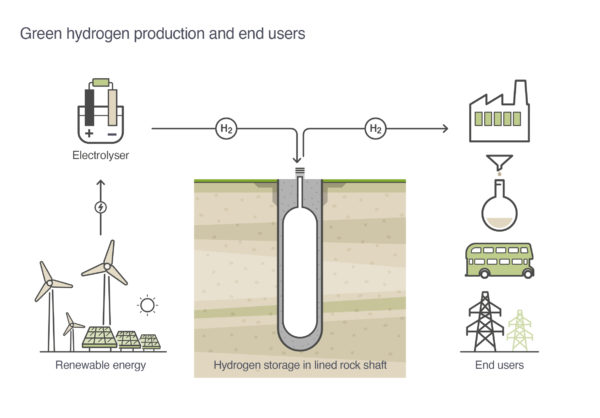From pv magazine Global
Gravitricity, a Scottish energy storage specialist, has signed a memorandum of understanding with structural engineering contractor VSL Systems UK to develop its first full-scale demonstration project in the United Kingdom for the underground storage of hydrogen. The company told pv magazine that initial use cases for its purpose-built storage systems will include industrial uses and heavy transport, so the systems will likely be located at industrial sites.
Gravitricity’s FlexiStore technology can store up to 1,000 tons of compressed gaseous hydrogen per shaft, and multiple shafts can be co-located at a single site. Current salt mine storage solutions do not provide for flexibility of location, but the FlexiStore system can be installed close to renewable energy facilities, where green hydrogen storage can also help to provide grid-balancing services.
“A single FlexiStore would store the green hydrogen generated by a 460 MW offshore wind farm and could be emptied and refilled daily,” the company said in a statement, noting that multiple shafts “could soak up vast amounts of otherwise wasted or ‘constrained’ wind – which amounted to 3.6 TWh in 2020.”
Gravitricity said its underground steel-lined rock shafts will be safer than current above-ground storage technologies, which have a higher risk of damage and leaks. Under the terms of the deal, VSL Systems UK will contribute its expertise to the design and construction of the FlexiStore structures, which will be 6 metres in diameter and 365 metres deep, with a capacity of 100 tons of gaseous hydrogen at 220 bar.
Gravitricity estimates that the daily storage capacity could be sufficient to refuel more than 1000 HGVS, or to power 500 buses for a week.

A Gravitricity spokesperson told pv magazine that FlexiStore systems will eventually also tap into the potential of gravitational energy, as heavy weights (up to 12,000 tons) are dropped through the hydrogen stored in the shaft. The company is in advanced discussions with Bendalls Engineering to fabricate the linings for the rock shafts, and it is seeking funds for the UK demonstration project.
The company’s gravity-based storage technology is currently being demonstrated in existing mine shafts in Czechia. The technology purportedly has a faster response time than lithium-ion storage technology and can help to stabilize electricity networks at 50 Hz by responding to full power demand in less than a second.
This content is protected by copyright and may not be reused. If you want to cooperate with us and would like to reuse some of our content, please contact: editors@pv-magazine.com.








220 bar is almost 3,200 psi.
It takes almost 40% of the energy in hydrogen to compress it for this type of storage.
The net efficiency of converting renewable energy to hydrogen is about 60% at best. Add a 40% loss for storage and you get to about 35%. The net efficiency for converting the compressed hydrogen back into electricity at grid scale in large power plants is 40% at best. So the round to round efficiency using this storage tech for renewable electricity to hydrogen to electricity is about 20%. The real math matters…